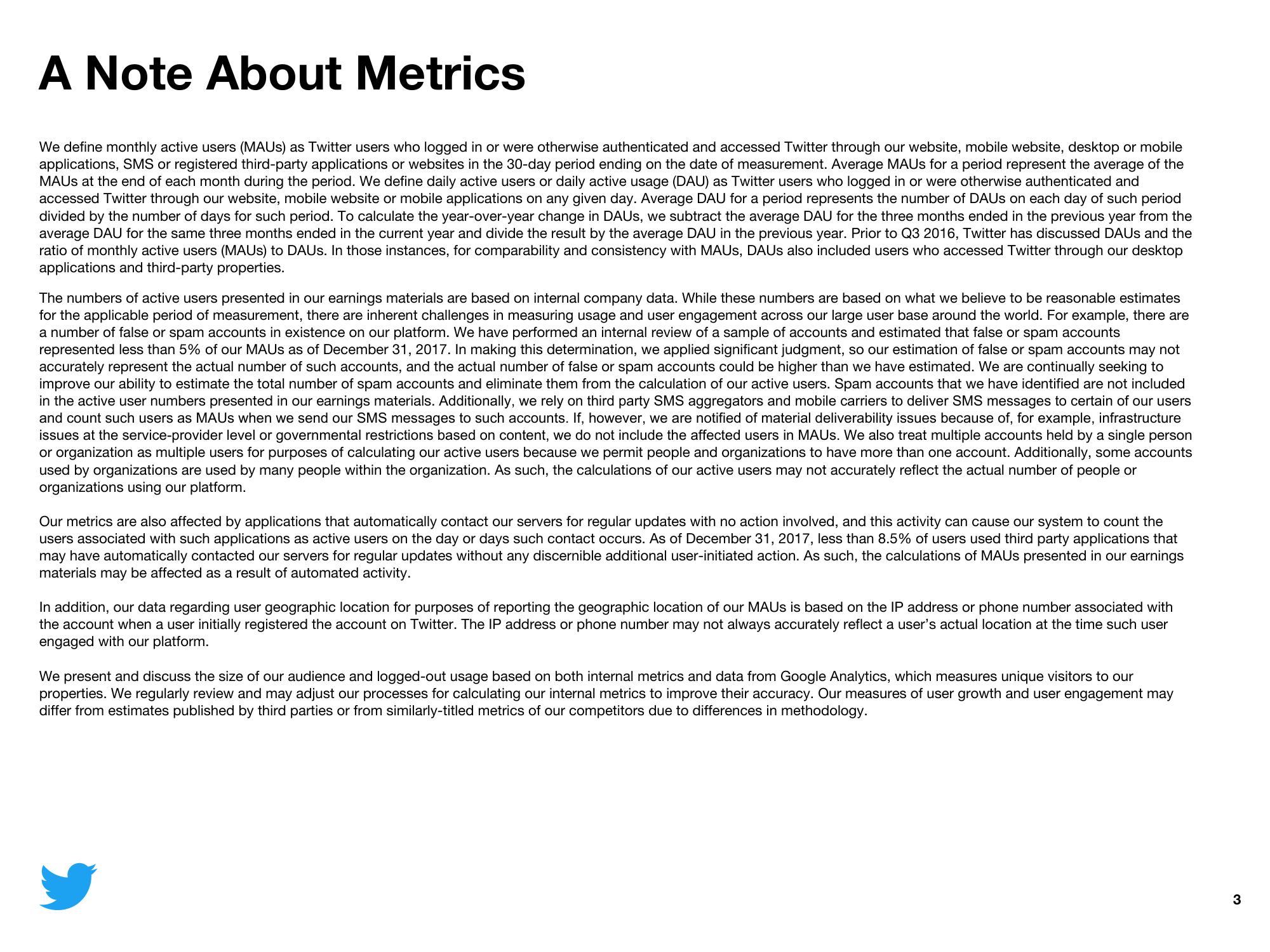Twitter Results Presentation Deck
A Note About Metrics
We define monthly active users (MAUS) as Twitter users who logged in or were otherwise authenticated and accessed Twitter through our website, mobile website, desktop or mobile
applications, SMS or registered third-party applications or websites in the 30-day period ending on the date of measurement. Average MAUs for a period represent the average of the
MAUS at the end of each month during the period. We define daily active users or daily active usage (DAU) as Twitter users who logged in or were otherwise authenticated and
accessed Twitter through our website, mobile website or mobile applications on any given day. Average DAU for a period represents the number of DAUS on each day of such period
divided by the number of days for such period. To calculate the year-over-year change in DAUS, we subtract the average DAU for the three months ended in the previous year from the
average DAU for the same three months ended in the current year and divide the result by the average DAU in the previous year. Prior to Q3 2016, Twitter has discussed DAUS and the
ratio of monthly active users (MAUS) to DAUS. In those instances, for comparability and consistency with MAUS, DAUS also included users who accessed Twitter through our desktop
applications and third-party properties.
The numbers of active users presented in our earnings materials are based on internal company data. While these numbers are based on what we believe to be reasonable estimates
for the applicable period of measurement, there are inherent challenges in measuring usage and user engagement across our large user base around the world. For example, there are
a number of false or spam accounts in existence on our platform. We have performed an internal review of a sample of accounts and estimated that false or spam accounts
represented less than 5% of our MAUS as of December 31, 2017. In making this determination, we applied significant judgment, so our estimation of false or spam accounts may not
accurately represent the actual number of such accounts, and the actual number of false or spam accounts could be higher than we have estimated. We are continually seeking to
improve our ability to estimate the total number of spam accounts and eliminate them from the calculation of our active users. Spam accounts that we have identified are not included
in the active user numbers presented in our earnings materials. Additionally, we rely on third party SMS aggregators and mobile carriers to deliver SMS messages to certain of our users
and count such users as MAUs when we send our SMS messages to such accounts. If, however, we are notified of material deliverability issues because of, for example, infrastructure
issues at the service-provider level or governmental restrictions based on content, we do not include the affected users in MAUs. We also treat multiple accounts held by a single person
or organization as multiple users for purposes of calculating our active users because we permit people and organizations to have more than one account. Additionally, some accounts
used by organizations are used by many people within the organization. As such, the calculations of our active users may not accurately reflect the actual number of people or
organizations using our platform.
Our metrics are also affected by applications that automatically contact our servers for regular updates with no action involved, and this activity can cause our system to count the
users associated with such applications as active users on the day or days such contact occurs. As of December 31, 2017, less than 8.5% of users used third party applications that
may have automatically contacted our servers for regular updates without any discernible additional user-initiated action. As such, the calculations of MAUS presented in our earnings
materials may be affected as a result of automated activity.
In addition, our data regarding user geographic location for purposes of reporting the geographic location of our MAUS is based on the IP address or phone number associated with
the account when a user initially registered the account on Twitter. The IP address or phone number may not always accurately reflect a user's actual location at the time such user
engaged with our platform.
We present and discuss the size of our audience and logged-out usage based on both internal metrics and data from Google Analytics, which measures unique visitors to our
properties. We regularly review and may adjust our processes for calculating our internal metrics to improve their accuracy. Our measures of user growth and user engagement may
differ from estimates published by third parties or from similarly-titled metrics of our competitors due to differences in methodology.
3View entire presentation